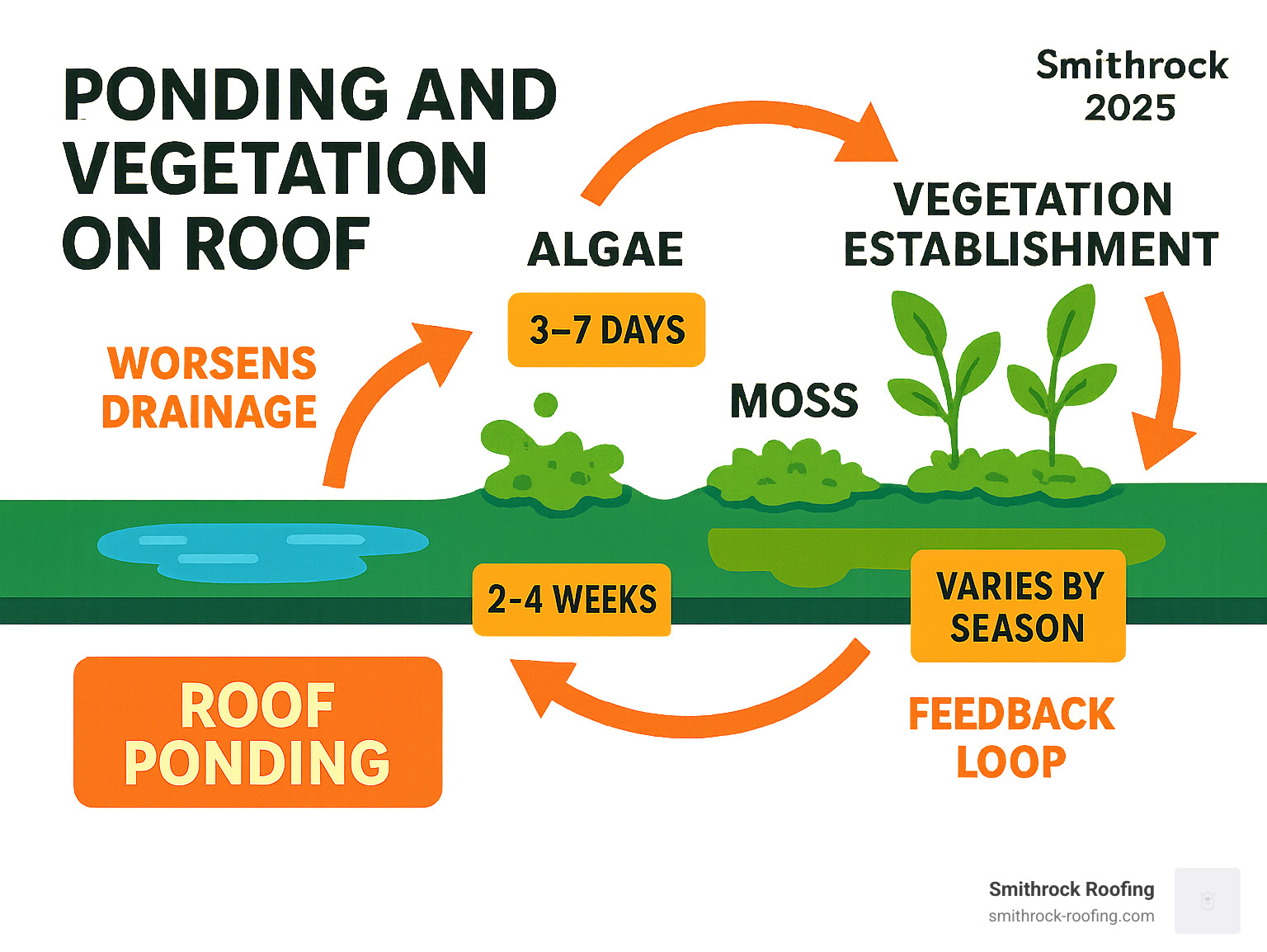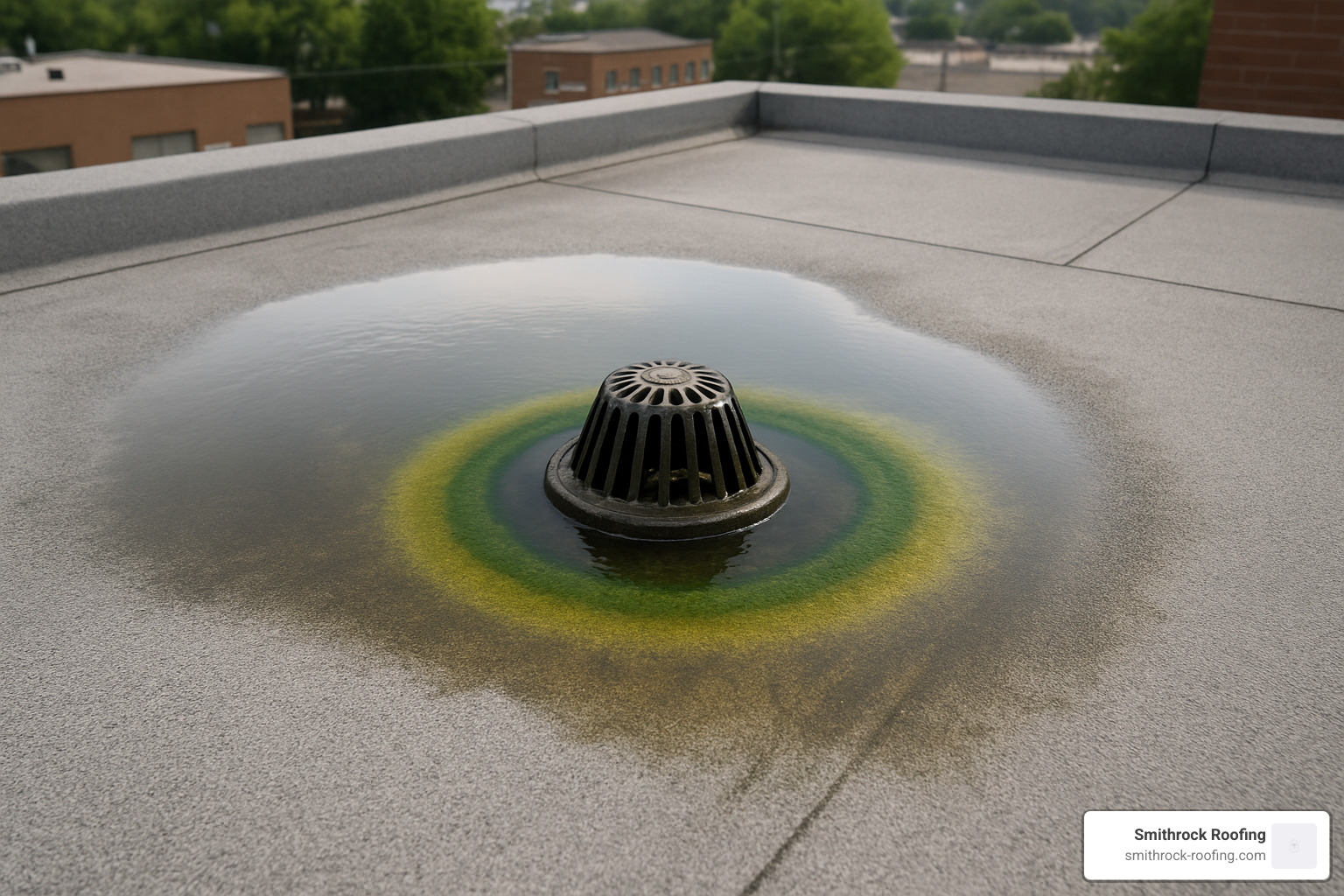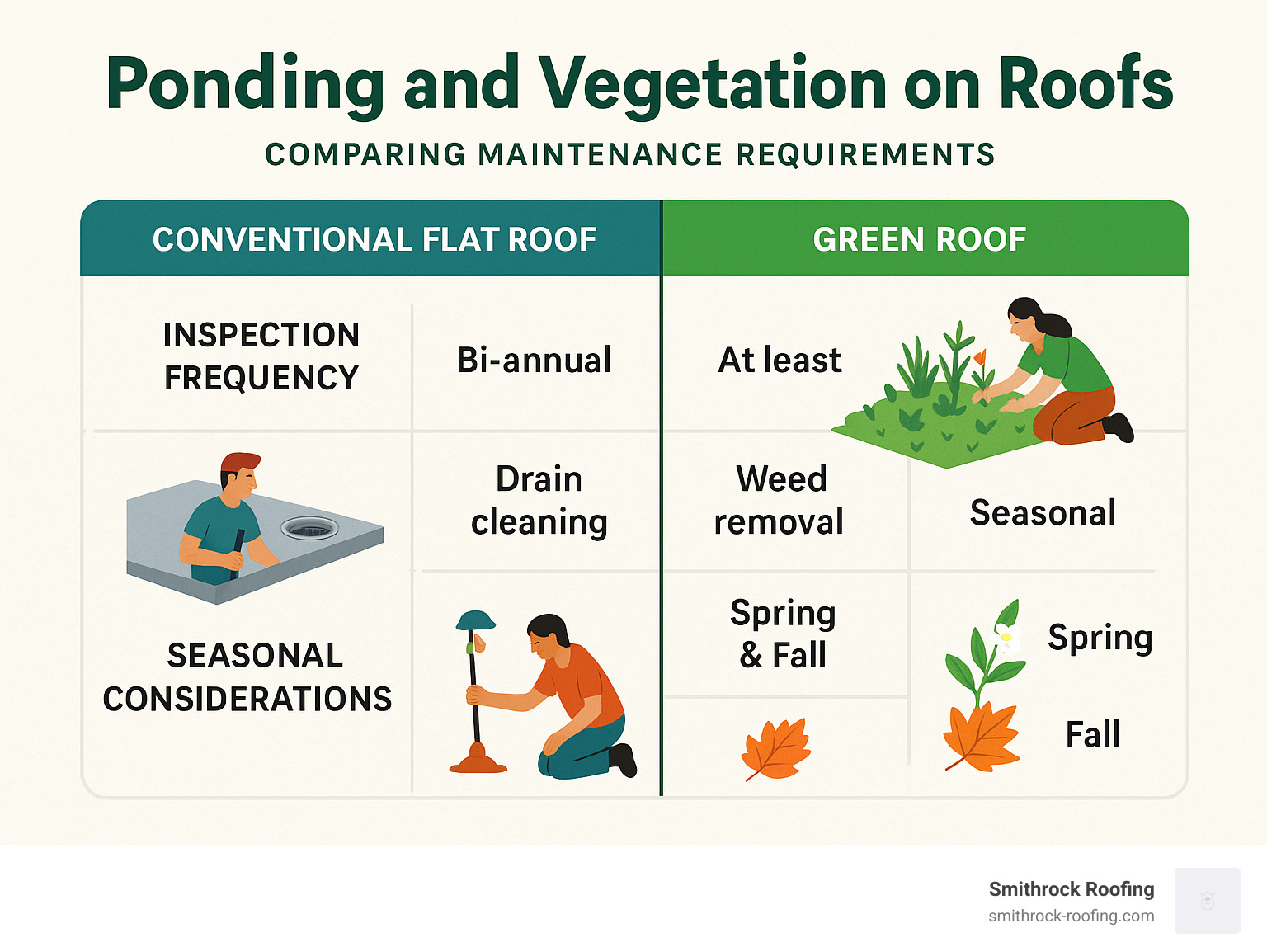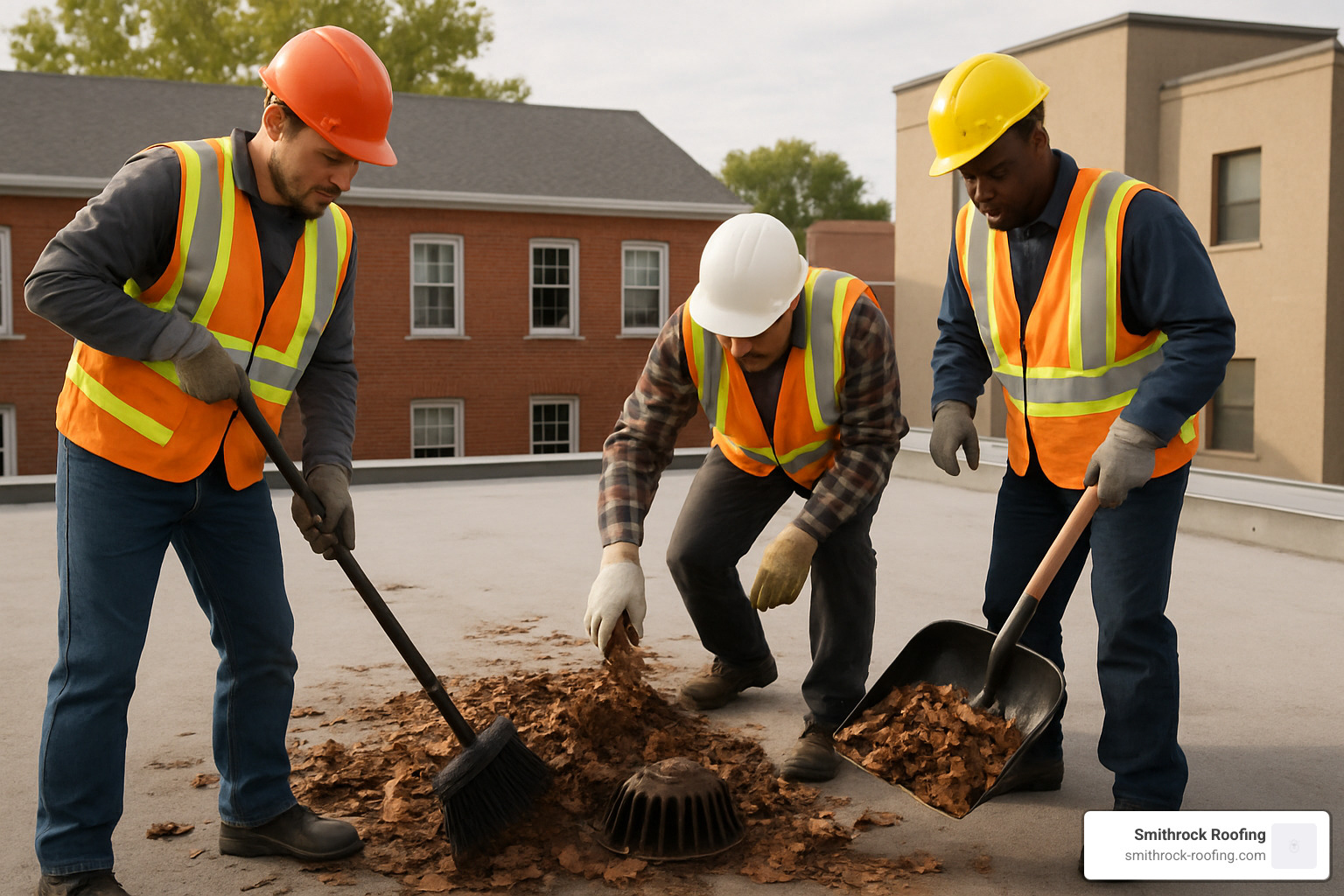Ponding and vegetation on roof systems create a destructive cycle that can turn your protective barrier into a swampland nightmare. When water sits on your roof for more than 48 hours, it becomes a breeding ground for algae, moss, and unwanted plants that can compromise your home’s structural integrity.
Quick Answer for Homeowners:
Standing water on your roof might seem harmless at first glance. But according to the National Roofing Contractors Association (NRCA), any water that remains for 24-48 hours signals a serious problem. The weight alone can stress your roof structure, while the moisture creates perfect conditions for biological growth.
What starts as a small puddle quickly becomes a miniature ecosystem. Algae blooms within days. Moss follows within weeks. Seeds carried by wind and birds take root in the nutrient-rich environment. The feedback loop is particularly troubling – vegetation doesn’t just grow in ponded areas, it makes ponding worse by clogging drains and retaining more water.
I’m Jordan Smith, and in my 15+ years of exterior construction experience, I’ve seen how quickly ponding and vegetation on roof issues can escalate from minor maintenance concerns to major structural problems. Through Smithrock Roofing, I’ve helped countless homeowners understand and address these interconnected challenges before they become costly disasters.

When you spot a puddle on your roof after a storm, you might think it’s no big deal. But the relationship between standing water and plant growth is like watching a slow-motion disaster unfold on your home’s most important protective barrier.
The National Roofing Contractors Association (NRCA) has a clear rule: any water that sits on your roof for more than 48 hours is officially “ponding water” – and it’s a red flag that something’s wrong with your drainage system.
Water doesn’t just sit there looking innocent. It weighs about 8.34 pounds per gallon, which means even a shallow puddle can add thousands of pounds of stress to your roof structure. That extra weight causes your roof deck to sag slightly, creating an even deeper depression that holds more water.
Standing water creates a five-star resort for unwanted biological guests. Algae spores are floating around everywhere in our North Carolina air, just waiting for the right opportunity. Give them moisture, a little warmth, and some sunlight, and they’ll set up shop within 3-7 days. Moss follows within 2-4 weeks, and seeds from grasses and weeds find this nutrient-rich environment irresistible.
The 24-48 hour rule isn’t just some arbitrary number that roofing professionals made up. It’s based on decades of real-world experience and research into how roof systems actually behave.
Most properly designed roofs should either drain completely or allow water to evaporate within this timeframe under normal conditions. Building codes require flat roofs to have at least a 1/4 inch per foot slope (about 2%) to ensure positive drainage.
The key thing to understand is the difference between temporary water accumulation during a heavy downpour and persistent ponding and vegetation on roof problems. Your roof might look like a small lake during an intense thunderstorm – that’s normal. But if you’re still seeing puddles two days after the weather clears, you’ve got a problem that needs addressing.
The timeline for plant establishment in ponded areas is faster than most people expect, especially in our warm, humid North Carolina climate.
Algae is the speed demon of the plant world. Those microscopic spores only need moisture, a few nutrients, and some light to start their takeover. In areas like High Point and Kernersville, we typically see algae blooms within a week of persistent ponding.
Moss takes a bit longer to establish – usually 2-4 weeks – but it’s much harder to remove once it gets comfortable. The real troublemakers are the seeds from grasses, weeds, and other plants that arrive like uninvited party guests. Wind carries them, birds drop them, and they even hitchhike on maintenance workers’ clothing.
For green roofs, the 3-hour drainage rule exists because these systems are designed to support vegetation – but controlled, intentional vegetation. When water stands longer than 3 hours, it often means the growing medium has become compacted or drainage systems are failing.
When I explain to homeowners how ponding and vegetation on roof systems cause damage, I often compare it to leaving a wet sponge on your wooden deck for months. The damage happens slowly at first, then accelerates dramatically as multiple problems feed off each other.
Standing water acts like a magnifying glass, concentrating UV rays and cooking your roof membrane from above. Meanwhile, the constant moisture attacks the materials from below. A roof membrane that should last 20+ years might deteriorate in just a few seasons under these conditions.
The weight problem gets worse over time. When water first starts ponding in a small area, it might only add a few hundred pounds of stress to your roof deck. As the deck begins to sag under this load, it creates a deeper depression that holds even more water. I’ve seen roofs where a puddle the size of a kiddie pool grew into a pond covering half the roof.
The freeze-thaw cycles we get here in North Carolina add another brutal twist. When that ponded water freezes, it expands with incredible force – enough to rip open membrane seams and create instant leak pathways.
Vegetation makes everything worse because plants are remarkably good at what they do – survive and spread. Moss and algae don’t just sit on your roof surface looking unsightly. They produce organic acids that literally eat away at roofing materials. Meanwhile, their roots work like tiny crowbars, prying apart membrane seams and creating entry points for water.
The Scientific research on low-slope drainage documents these damage mechanisms in detail, and the findings are sobering for anyone with a flat roof.
Deck deflection is usually where the trouble starts. Picture your roof deck like a trampoline – it’s strong, but when you add weight in one spot, it creates a depression. Now imagine that depression fills with water, making it even heavier, which creates a deeper depression.
The insulation problems that follow are particularly nasty. When water finally penetrates your membrane, it soaks into the insulation below like a sponge. Wet insulation is not only useless for keeping your home comfortable – it becomes incredibly heavy and a mold factory.
The membrane deterioration happens faster than most people realize. Constant moisture exposure breaks down the chemical bonds in roofing materials. Add vegetation into the mix, and you’ve got organic acids attacking the membrane while roots physically puncture it.
Drainage system failure creates the most vicious cycle of all. When moss and debris clog your drains, water backs up and creates larger ponded areas. These bigger wet zones support more vegetation growth, which clogs more drains.
Green roofs present unique challenges because they’re designed to support plant life – but only the right plants in the right conditions.
Root rot becomes the enemy of everything you’re trying to accomplish with a green roof. Most green roof plants are chosen specifically because they thrive in well-drained conditions. When water starts standing around their roots, these tough, drought-tolerant plants can die surprisingly quickly.
Growing media compaction turns your carefully engineered soil into concrete. The lightweight growing medium becomes waterlogged and compacts under its own weight. Once this happens, drainage gets even worse, creating more ponding and more compaction.
Plant die-off creates a domino effect of problems. Dead vegetation doesn’t just disappear – it decomposes, creating organic sludge that clogs drainage systems. The bare patches left behind become prime real estate for weeds.
For detailed Inspection guidance for green roofs, specialized protocols help identify these problems before they become disasters.
What starts as an innocent puddle on your roof can transform into a thriving plant community faster than you’d expect. The journey from water to weeds begins with something called capillary wicking. Even after surface water seems to evaporate, moisture gets trapped in tiny cracks, joints, and porous materials around your roof.
Nature has a way of turning any wet spot into a buffet. Dust settles into ponded areas, along with pollen, bird droppings, and bits of organic debris carried by wind. Before long, you’ve got a nutrient-rich soup that makes plants feel right at home.
Shallow ponds on roofs actually act like solar collectors. Instead of cooling the surface, they warm up the water and create humid little microclimates that many plant species absolutely love. Seeds can sit dormant on your roof for months or even years, just waiting for the right conditions.
Different plants show up at different stages of this unwelcome change, and each brings its own set of problems.
Algae typically wins the race, often appearing within just a few days of persistent ponding. Blue-green algae can form surprisingly thick mats that trap moisture and organic matter.
Moss follows close behind and can quickly carpet entire ponded areas. What makes moss particularly troublesome is its survival strategy – it can go completely dormant during dry spells, then bounce back to life the moment moisture returns.
Sedum species are actually quite beautiful and are intentionally used on green roofs, but they become problematic when they decide to set up shop in unplanned locations. They’re incredibly drought-tolerant and can establish in surprisingly thin soil layers.
Grasses and weeds need more organic matter to get established, but once they do, they pose the biggest threat. Their aggressive root systems can cause serious membrane damage. I’ve seen cases where grass roots punched completely through membrane systems.
Here’s where things get really frustrating – the plants don’t just grow in the wet spots, they actually make the ponding problem worse.
Root-clogged drains are the most obvious culprit. Plants naturally grow toward consistent moisture sources, so their roots head straight for your drainage points. Even small root intrusions can trap debris and reduce drainage capacity.
The weight of accumulated biomass becomes a serious structural concern. A thick mat of moss and algae can hold several times its own weight in water. During inspections around Mt. Airy and Pilot Mountain, I’ve measured vegetation mats that added over 20 pounds per square foot to the roof loading.
Plants actively retain moisture long after the original ponding would have evaporated naturally. They create persistently damp conditions that support continued growth and expand the suitable habitat for new plant establishment.

Staining and discoloration are often your first clues. Algae growth typically creates green or black stains that spread outward from ponded areas. Rooftop odors from stagnant water and decomposing organic matter create distinctive musty smells. Mosquito activity serves as both a health concern and an early warning system. Surface texture changes happen as vegetation establishes and thickens.
Taking care of ponding and vegetation on roof problems before they become expensive disasters is like maintaining your car – a little regular attention saves you from major headaches down the road.
Bi-annual inspections form the backbone of smart roof care. I recommend thorough check-ups in spring and fall, plus quick looks after any major storms. Drain cleaning might not sound exciting, but it’s probably the most important thing you can do for your roof. Those drains need clearing at least twice a year.
Sometimes the original roof just doesn’t have enough slope to drain properly. That’s where tapered insulation comes in handy. This specialized insulation creates the slopes your roof needs to move water toward the drains.
Crickets and scuppers around roof equipment are crucial drainage features that guide water around obstacles like HVAC units. Don’t forget about HVAC condensate routing – your air conditioning system produces surprising amounts of water that needs proper drainage.

You can safely check for obvious issues from the ground using binoculars, or from roof access points if you’re comfortable with heights. Look for standing water, green staining, visible vegetation growth, and clogged drains.
But infrared moisture detection reveals wet insulation and hidden leaks long before they become visible problems. Professional thermal imaging shows exactly where moisture is accumulating, even when the surface looks perfectly dry. Moisture probe testing provides actual measurements of how wet your insulation has become.
For homeowners throughout our Winston-Salem and Greensboro service areas, our comprehensive roofing services include thorough professional inspections that catch problems before they become expensive repairs.
Positive drainage design should be your foundation – literally. This means creating slopes that actively push water toward drains. Multiple drain systems provide the backup you need when one drain gets clogged. Emergency overflow systems activate when your primary drains get overwhelmed during heavy storms. Root barrier installation protects against vegetation problems.
Spring cleaning in March and April focuses on clearing winter debris from drains, inspecting for freeze-thaw damage, checking membrane seams, removing vegetation, and testing drainage systems.
Post-storm inspections happen whenever Mother Nature throws a tantrum. Check for new ponding areas within 48 hours, clear storm debris, document damage, and remove standing water if it hangs around longer than 48 hours.
Fall preparation in October and November means removing leaves and organic debris, inspecting gutters, checking for summer vegetation growth, and preparing drainage systems for winter weather.
Snow melt monitoring during winter involves watching for ice dam formation, clearing snow from drains when safely accessible, and monitoring for ponding during thaw periods.

Knowing when to put down the garden hose and pick up the phone can save you thousands of dollars in repairs. While homeowners can handle basic maintenance, certain warning signs mean it’s time to call in the cavalry.
Structural sagging should make you back away from your roof immediately. If you notice any depression, sagging, or “soft spots” in the roof surface, treat it like a medical emergency for your home.
The sight of water that’s been sitting for more than 48 hours after a storm is your cue to call a professional. Persistent ponding indicates a fundamental problem that needs expert diagnosis. Vegetation mats that look like they’ve settled in for the long haul require professional removal. Interior leaks are the ultimate wake-up call.
Don’t forget about warranty requirements either. Many roof warranties specify that certain types of work must be performed by certified professionals to maintain coverage.
For comprehensive guidance on roof repair vs replacement, professional assessment helps determine the most cost-effective approach for your specific situation.
Flat roof experience is non-negotiable. A contractor who primarily works on steep-slope residential roofs might be excellent at shingle replacement but completely out of their depth with complex drainage issues.
Green roof certification becomes essential if you’re dealing with an intentional vegetated roof system. Professional leak detection tools separate the pros from the wannabes. Quality contractors invest in infrared cameras, moisture meters, and electronic leak detection equipment.
References from similar projects provide the best insight into a contractor’s real-world capabilities. Ask specifically for examples of ponding remediation and vegetation removal projects in your area.
Water removal should be your first priority if ponding covers large areas or the roof structure appears stressed. Use pumps, wet vacuums, or other appropriate equipment to remove standing water. However, avoid walking on saturated or sagging roof areas.
Clearing obvious debris can sometimes restore drainage function if blockages are causing the ponding. Document everything with photographs from multiple angles. Install safety barriers if you suspect structural damage. Contact your insurance company promptly if damage is suspected.
Here’s the straightforward answer: any water that sits on your roof for more than 48 hours is cause for concern. It doesn’t matter if it’s a small puddle or a large pond – persistent standing water signals a problem that needs attention.
The NRCA guidelines aren’t just arbitrary rules. They’re based on decades of real-world experience showing that water remaining beyond this timeframe creates conditions for membrane damage and biological growth.
The timing matters more than the depth. Your roof might look like a small lake during a heavy thunderstorm, and that’s often normal. But if you’re still seeing the same puddles in the same spots two days after the weather clears, you’ve got a drainage problem.
This question comes from a common misunderstanding about how green roofs actually work. Properly designed green roofs should not have standing surface water for extended periods, even though they’re designed to manage stormwater.
The key is understanding the difference between water retention and water ponding. Green roofs retain moisture within the engineered growing medium where plant roots can access it. But surface water should infiltrate or drain within 3 hours after a storm event.
When water stands on the surface longer than 3 hours, it usually indicates problems like media compaction, clogged drainage systems, or installation issues.
The honest answer is: it depends on what’s growing and how long it’s been there. Surface algae and newly sprouted moss can often be removed carefully, but established plants with root systems are a different story entirely.
Timing is everything with vegetation removal. That green film you noticed last week? Probably removable with gentle cleaning. The thick moss mat that’s been there all summer? That’s going to require professional assessment to avoid membrane damage.
Root systems are the real concern. Once plants establish roots that penetrate the membrane, removal becomes much more complicated. The safest approach is always professional evaluation before attempting removal.
That puddle on your roof might look harmless, but ponding and vegetation on roof systems create a perfect storm of destruction that can turn your protective barrier into an expensive nightmare.
Time is your enemy when it comes to roof ponding. That 48-hour rule isn’t just some arbitrary number – it’s your early warning system. Once water sits longer than two days, you’re dealing with the beginning of a biological takeover that gets harder and more expensive to stop with each passing week.
Prevention beats panic every single time. Proper drainage design and regular maintenance might seem like unnecessary expenses, but they’re pocket change compared to emergency repairs and structural damage.
The feedback loop is real and relentless. Vegetation doesn’t just grow in wet spots – it creates more wet spots. Roots clog drains, which creates bigger puddles, which support more plants, which clog more drains.
Professional expertise isn’t optional for serious problems. While you can certainly keep an eye on your roof and clear obvious debris, established vegetation and persistent ponding require specialized knowledge.
Living here in North Carolina, we know how quickly our warm, humid climate can turn a small roof issue into a botanical garden. From Winston-Salem to Greensboro, the weather conditions are perfect for the kind of biological growth that destroys roofs.
At Smithrock Roofing, we’ve built our reputation on understanding that your roof is more than just shingles and membranes. It’s the shield that protects everything you’ve worked for. When ponding and vegetation on roof problems threaten that protection, we have the experience and technology to identify issues early and fix them right.
Don’t wait for the problem to announce itself with interior leaks or visible structural damage. If you’re seeing persistent puddles, suspicious staining, or any kind of green growth up there, it’s time for professional evaluation.
Whether you’re dealing with storm-related drainage issues or long-term maintenance concerns, our team provides comprehensive storm damage roof repair services that address both immediate problems and long-term prevention strategies.
Your roof doesn’t have to become a science experiment. With the right knowledge, regular attention, and professional support when needed, you can maintain a dry, durable roofing system that does its job quietly and effectively for decades.
The choice is simple: address ponding and vegetation issues early, or deal with much bigger problems later. We’re here to help you make the smart choice.

Smithrock Roofing © Copyright 2025 • All Rights Reserved • Maintained by Mongoose Digital Marketing